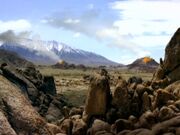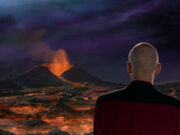AT: "xx"
 |
Warning! This page contains information regarding new Star Trek material, and thus may contain spoilers.
|

A volcano on Hanon IV

Picard watching a volcano on Earth

The volcano on Nibiru
A volcano is an opening in a planet's crust, often formed into a mountain, from which molten lava and gases are ejected.
The study of volcanoes is volcanology. (TNG: "Pen Pals")
Ocampa had a range of several extinct volcanoes. (VOY: "Caretaker")
Volcanoes on Penthara IV were activated when subterranean pockets of carbon dioxide were opened by a phaser drill. The volcanoes started to erupt and produced large plumes of volcanic dust, threatening to bring another ice age on the planet. (TNG: "A Matter of Time")
Volcanic vents could supply enough heat to sustain life even on rogue planets. An example of such a world was Dakala. (ENT: "Rogue Planet")
Captain Jean-Luc Picard saw an active volcano on Earth in the region of France about 3.5 billion years ago, when Q brought him there. (TNG: "All Good Things...")
In the alternate reality, a supervolcano on Nibiru threatened to destroy all life on the planet, including the indigenous Nibirans. The threat was averted when Spock, wearing an especially heat-resistant environmental suit, activated a cold fusion device in the magma chamber, rendering the volcano inert. (Star Trek Into Darkness)
Noted volcanoes
Appendices
Additional references
- VOY: "Basics, Part II"
- ENT: "Dawn"
Background information
Volcanoes in VOY: "Basics, Part II" were shown with matte paintings. (Cinefantastique, Vol. 29, No. 6/7, p. 112)
The group tasked with depicting the volcano in Star Trek Into Darkness obviously had to find a way to do so without subjecting Spock actor Zachary Quinto to the harsh conditions of an actual volcano. (Star Trek Magazine issue 172, p. 48) A concept illustration of the volcano can be viewed here. Precisely how the volcano sequence would be filmed was the subject of some early discussions between Visual Effects Supervisor Roger Guyett and Cinematographer Dan Mindel. They opted against shooting the sequence indoors, Mindel then deciding that the necessary live-action footage would be captured on a night shoot. [1]
Part of the volcano in Star Trek Into Darkness was built as a physical set, outdoors in Marina del Rey in California. [2] The set was comprised of an eighty-foot-long set of volcanic rocks backed by green-screen and was located on the Playa Vista lot. (Cinefex, No. 134, p. 78) Despite the fabricated nature of the set, the production team endeavoured, for Zachary Quinto's benefit, to give the environment a realistic ambience and a sense of feasibility, using such elements as heat, light sources and smoke to provide interaction. Related Roger Guyett, "You weren’t standing on a green rock, you were standing on a textured surface and you had smoke and stuff was blowing through." [3]
The production crew filmed the volcano sequence at night. (Cinefex, No. 134, p. 78) Dan Mindel remarked, "We shot it all at night so we could control the lights and manipulate it so that the steam that we were making would block out the sun and give us a lot of texture. All the sparks and fire is real." [4] The team used fire-bars and ember-generators to create the on-set pyrotechnics. To produce the sparks, the creative staff adopted one of the oldest special effects in Hollywood, which used to commonly be employed to make campfire sparks in movies set in the Wild West; the group used a Venturi air system to inject particulate – which, to generate the sparks, had to be ground-up, organic material – into an extremely hot flame, resulting in the airflow creating embers that flew into the sky. "We went to a commercial supplier and bought very fine ground charcoal, made from burnt coconut shells," remembered Special Effects Supervisor Burt Dalton. "We placed about a dozen blower motors around the set, with two or three weed burners per source to create heat. Then we installed Venturi devices, injected the ground charcoal into the airflow, which ignited the product, and the high-pressure airflow jettisoned massive amounts of embers into the sky." (Cinefex, No. 134, p. 78)
The full effect of the volcano relied, of course, on visual effects, courtesy of the film's VFX team. In fact, apart from the live-action footage, Roger Guyett wanted additional aspects of the volcano to be achieved with an entirely CGI approach. This was influenced by having worked on a tricky volcano sequence in Star Wars Episode III: Revenge of the Sith, set on the fiery planet Mustafar and incorporating practical, miniature and digital work. Under Guyett's supervision, Industrial Light & Magic supplied digital backgrounds, lava simulations, embers and additional smoke for the Nibiran volcano. [5] The company used a three-dimensional model of Spock's volcano suit to reflect environment projections of the vast lava-filled cavern. The visual effects artists also generated a flat plane of the environment in CGI, before digitally mapping the volcano's churning contents. Fragmenting crust – floating on the surface of the lava and layered with heat distortions – as well as magma eruptions were all depicted in lava simulations which involved approximately forty render passes. "Roger then guided us to place explosions and geysers," continued CG Simulation Supervisor Dan Pearson. "We generated smoke by exporting particles from the sim and loaded those elements into our Zeno animation pipeline so we could see the effects interacting with the environment." (Cinefex, No. 134, pp. 78 & 81) Noted Guyett, "The guys worked very hard to capture the volatile nature of the lava, along with all the extra details, like the embers." Guyett went on to say that, because Nibiru was conceived as a different planet than Earth, "It didn't have to be completely based on the physics of our world. We could push some of the boundaries a little bit." (Star Trek Magazine issue 172, p. 48)
